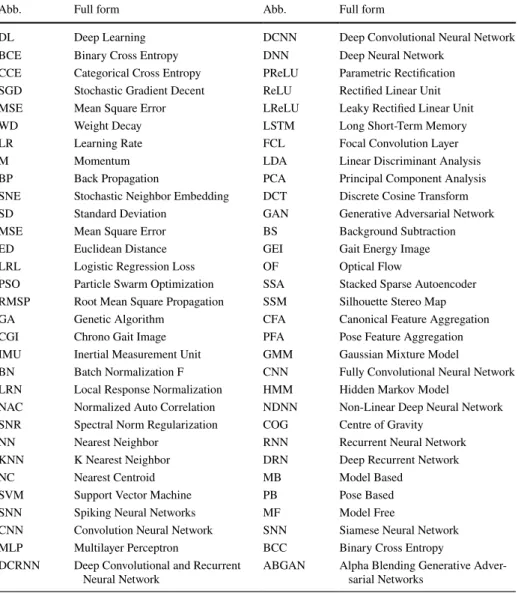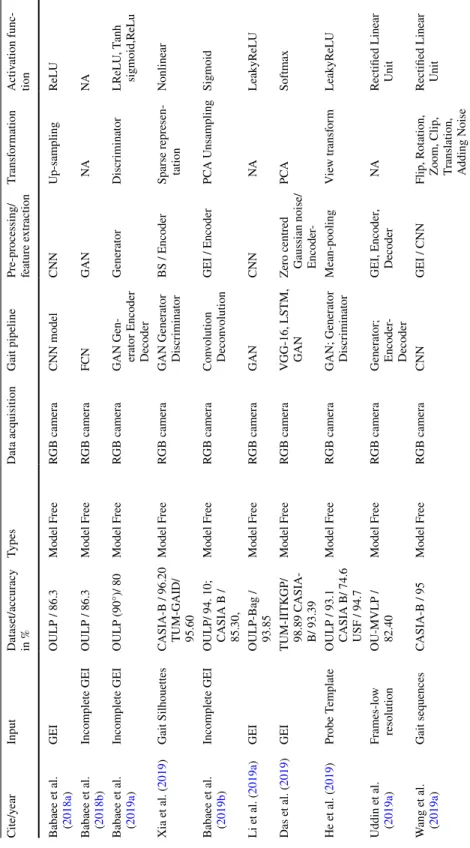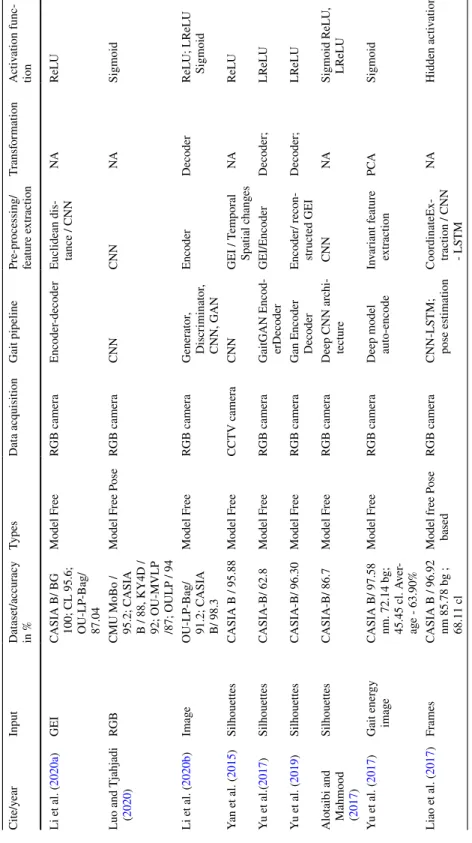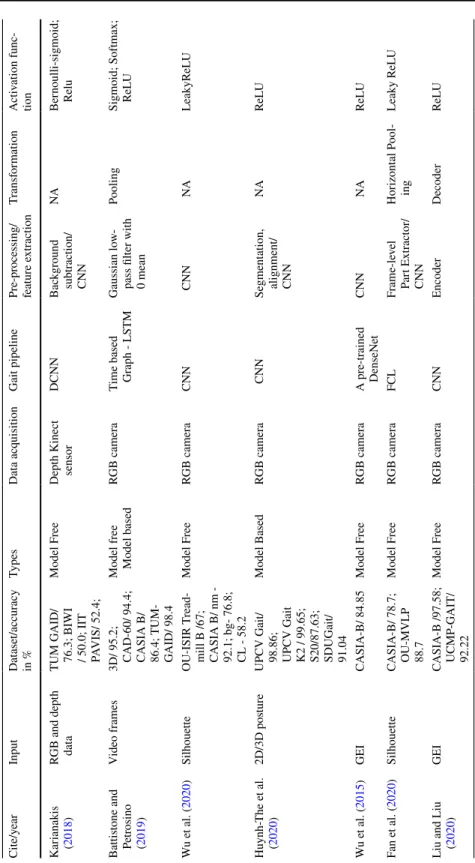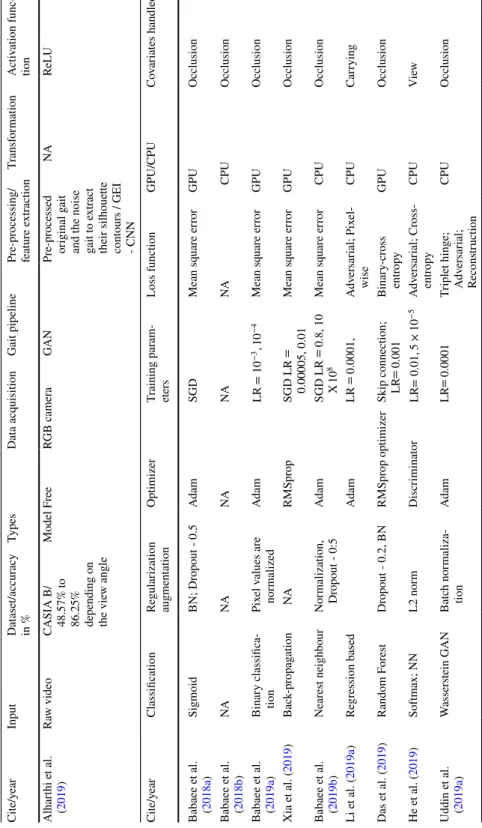GEI is a large descriptor that captures many details by averaging the gait cycle (Xu et al. 2019). Cross-entropy loss CPUCross-view Chao et al. 2019) Horizontal pyramid clustering Triple sampler, interpolation, argument parsing.
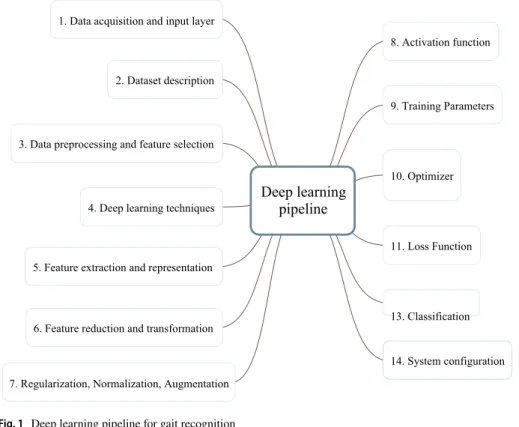
Dataset description
The large population dataset of OU-ISIR (Iwama et al. 2012) includes subjects with two cameras surrounding the ground they walk on. OU-ISIR large population dataset with age (Xu et al. 2017), includes individuals aged 2 to 90 years. OU-ISIR large population dataset with bag (Uddin et al. 2018) provides carry object details as a covariate.
OU-ISIR multi-view large population dataset with bag sequence (An et al. 2020), is built on OU-MVLP. CASIA gait database B (Yu et al. 2006) provides variation in clothing, wearability and variation in viewing angle. TUM-IITKGP gait database (Roy et al. 2011), provides occlusion sequences (long coat, hand in pocket, static occlusion, dynamic occlusion).
Feature selection and data preprocessing techniques
Deep learning techniques
- Feedforward network
- Generative adversarial network
- Recurrent network
- Hybrid learning
- Discriminative and user defined networks
Fully connected networks (FCNs) lack dense layers (as traditional CNNs do) and instead rely on 1x1 convolutions to perform the role of fully connected layers (dense layers) (Babaee et al. 2018b). VGG16 (also known as OxfordNet) is a convolutional neural network model capable of adapting to a wide range of input sizes (Sun and Liu 2018), and VGG-19 is a 19-layer deep convolutional neural network (Li et al. 2017b). It can use any network infrastructure suitable for data classification (Xia et al. 2019).
It can handle individual data points as well as entire data series (Li et al. 2019a). Jump links, or shortcuts, are used by residual neural networks to jump through certain layers (Yang et al. 2019). The goal is to mimic biological neural organization as closely as possible (Xu et al. 2019).
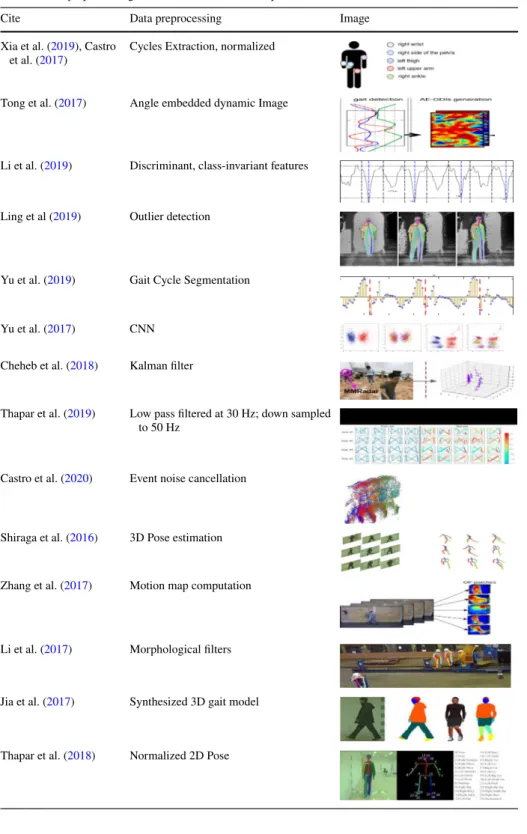
Feature extraction and representation
Deformable convolution and deformable RoI pooling are built on the concept of augmenting the spatial sampling positions with additional offsets. It will iteratively optimize the between-class distance metric to the within-class distance metric to discover the ideal matrix subspace where the gait energy images surrounding viewpoints are matched in horizontal and vertical coordinates (Ben et al. 2019). JUCNet (Joint Unique-gait and Cross-gait Network) is a network that combines the advantages of unique and cross-gait conditions, resulting in a significant increase in overall accuracy (Zhang et al. 2019d).
A position estimation network is a computer vision strategy for predicting and tracking the position of a person or object (Liao et al. 2017). 2D skeleton position estimation uses GPU acceleration to achieve real-time low-latency joint object identification and high-accuracy 2D landmark position estimation (Thapar et al. 2019). Super-resolution (SR) imaging strategies use deep back-projection networks to recreate a higher-resolution image or series (Wang et al. 2020b).
Feature reduction and transformation
It achieves this by generating new uncorrelated variables that optimize the variance in a sequential manner (Zhang et al. 2017). The hidden parameter would be converted by the decoder into the output sequence (Li et al. 2020b). A linear transformation is the process of preserving any vector space that is under a linear structure (Haque et al. 2016).
Local directional patterns are used to track walking edges in grayscale images (Uddin et al. 2019b). When multiple samples have the same distance to the reference sample, the first detected sample is used (Batchuluun et al. 2018). Aggregation is a way to reduce many variables to a few numerical values or figures (Delgado-Escaño et al. 2020).
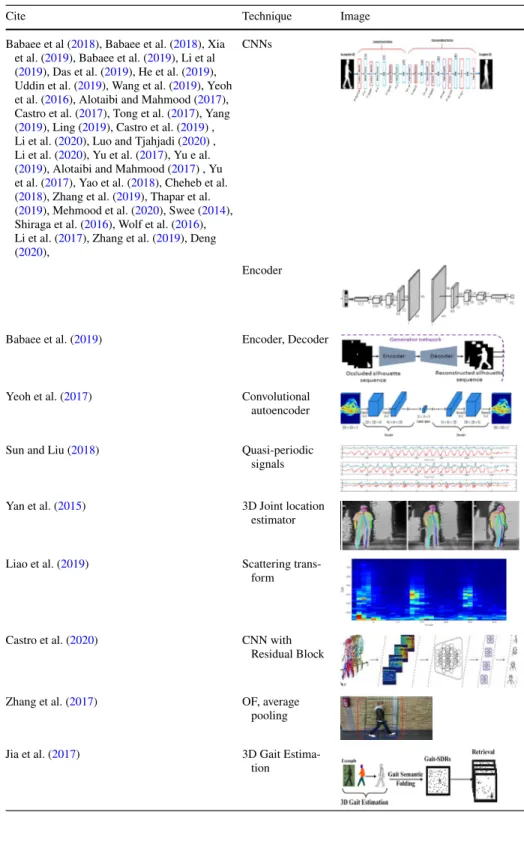
Normalization, augmentation, regularization
In a network, the assignment of inputs to the layers changes due to normalization layers (He et al. 2020). Normalization is often used with unit variance and zero-means (McLaughlin et al. 2016). In this standard, all components of the vectors are weighted equally (Li et al. 2019b).
A 2D Gaussian function is used to estimate the intensity distribution provided by a point source (Linda et al. 2020). It makes it easier to model intra-class variation in real-world gait datasets (Chao et al. 2019). As a result, the performance of the model on previously unseen data increases (Karianakis et al. 2017).
Activation function
Comparing a time series to itself at a given time is known as normalized autocorrelation (Li et al. 2017a). Convolution or convolution is the data augmentation technique to transform data for deep learning models (Wang et al. 2020b). Spectral rate tuning is a technique for reducing the robustness of a system to disturbances (Jia et al. 2019).
For each node in the last layer, softmax activation produces a single value (Zhang et al. 2019d). Hidden activation functions convert the obtained feedback into values within a manageable range (Liao et al. 2017). Each output dimension depends on each input dimension in a fully connected layer (Liu et al. 2018).
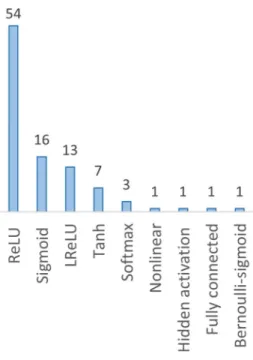
Training parameters
Backpropagation is a process that uses an optimization algorithm such as gradient descent (Swee et al. 2014). A low standard deviation means that the values are like the average value of the set, while a high standard deviation indicates that the values are spread over a larger spectrum (Rauf et al. 2016). Stochastic neighbor embedding (SNE) is an unsupervised nonlinear technique for discovering and visualizing high-dimensional data.
SNE provides a sense of how data is organized in a high-dimensional space (Costilla-Reyes et al. 2018). The activation feature can be shifted to the left or right using the bias value to best fit the results (Rauf et al.
Optimizer
To evaluate and visualize results, use least square error, where the objective (error) function is a quadratic function of a parameter(s) being optimized (Yu et al. 2017). In multiobjective optimization problems, the manhattan distance approach to decision making with multiple criteria is used (Mehmood et al. 2020). Cross-entropy loss increases as the expected probability differs from the actual label (Tong et al. 2018).
Discriminative power (Carley et al. 2019) across views is used to determine the most discriminating gait features. Zero-mean gaussian is used in (Song et al. 2019) and the value of standard deviation is one. Backpropagation is a technique to backpropagate errors while training the model (McLaughlin et al. 2016) by changing the parameters (weights and biases).
Loss function
Classification
It can use any network design suitable for the shape of the data being classified (Zhang et al. 2019e). The automatic encoder classification method is like anomaly detection, which learns the pattern of a regular operation (Zhang et al. 2019a). Classification algorithms are designed to classify class labels located near the root of the hierarchy (Castro et al. 2020).
The metric learning approach is used to automatically build distance measures from monitored results (Ben et al. 2019). When using triplet training pairs, the loss function is always triplet permutation loss (Xu et al. 2020). The length of a line segment connecting two points in Euclidean space is described as the Euclidean distance (Fan et al. 2020).
System configuration, GPU details, framework and language used
- Platform details
- System configuration
- Framework used
- Language used
Cross-reconstruction attempts to create latent relationships between various modalities and thereby reduce feature space distribution variations (Li et al. 2020a). As a result, regular vector norms, including city block, Euclidean, and intersection, can be used as distance scales (Jia et al. 2019). 2017)CPUCaffe software Zhang et al. 2019b) desktop with GeForce GTX 1080 Ti GPUGTX 1080 Ti GPUPythonPyTorch Framework Castro et al.
NVidia GeForce GTX 1070PythonKeras application programming interface (API) with tensorflow as backend engine Liu et al. 2018)CPUCafe Karianakis (2018)CPUCafe-to-Torch Battistone in Petrosino (2019)Regular SystemsCpuPythonTensorFlow, Scikit-learn, Numpy, OpenCV Wu et al. 2016)System with Nvidia GeForce GTX TITAN X Graphics CardNvidia GeForce GTX TITAN X Graphics CardPython McLaughlin et al. NVidia Titan X.Keras in Tensorflow Bhanu and Govindaraju (2011) pc with 2 NVIDIA 1080TI GPU's2 NVIDIA 1080TI GPU's Hayfron-Acquah et al. 2020)NVIDIA DGX-1 AI SupercomputerNVIDIA DGX-1 Zheng et al.
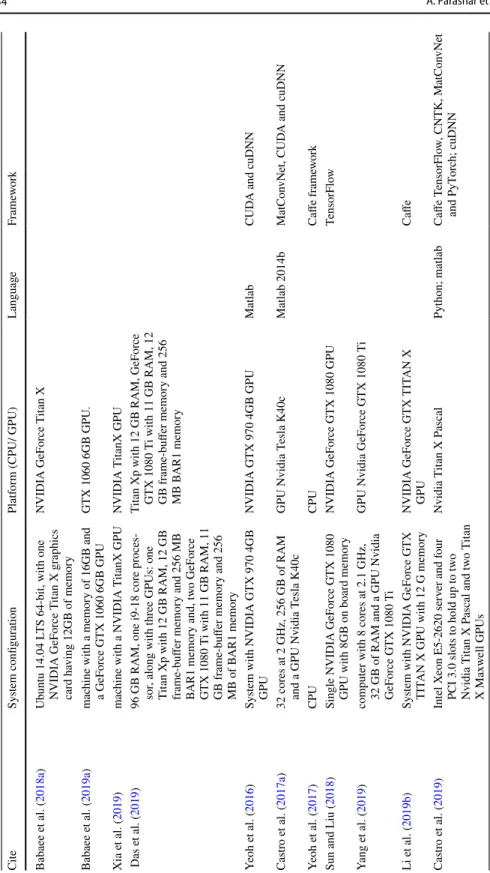
Shortcomings and solutions
Research gaps
2017)Good accuracyLess analysis in different partial walk cycles Level accuracy Sun and Liu (2018)Robust against holding together with occlusion Not suitable for real-time application Yang et al. 2019)Robust vs. appearance along with closure Does not generate PEI due to high dimensionality of GAN Li et al. 2014) Viewing angle not required Shiraga et al. 2016)Increased their interclass variation Dependence on viewing angle is high Wolf et al. 2020) High performance, consistent appearance Ignore wear and tear Ben et al. 2019) Works in real time Do not consider wear and tear Tong et al. 2019) Efficient view transformation model Low accuracy in cross-sectional views.
2019d) Evaluated on inter- and intraclass differences Less accurate results Wang et al. 2020a) Fusion of DL models No covariate condition considered Chao et al. 2019) Spatial heterogeneous Unaddressed wear and clothing Zhang et al. 2019d) See. -invariant Low accuracy Takemura et al. 2017) Works in real time Not addressed wear and clothing Zhang et al. 2019e) Protects temporal and spatial data Not considered occlusion Zhang et al. 2019f) See. 2020) 3D CNN to capture temporal features Computational complexity is high Huynh-The et al. 2020) Robust gait identification Expensive and not possible everywhere Wu et al. 2015) Capturing both spatial and temporal features Suffers from intraclass variations and occlusion.
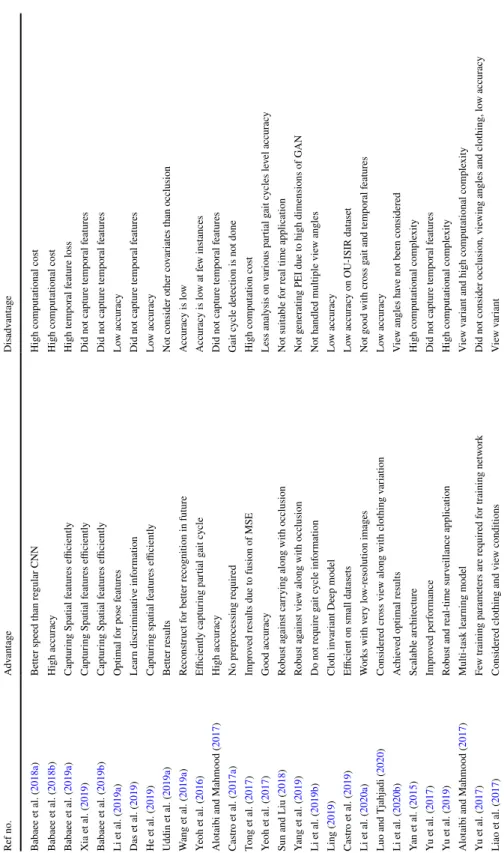
Possible solutions that can be tried
Real-time analytics is problematic due to the lack of real-time processing of deep learning architectures and massive datasets covering all relevant situations. Any covariate change in the dataset affects the quality of the deep learning model output. The deep learning architecture must be built in such a way that it can handle any data set.
The true power of deep learning can be seen when training with larger datasets, such as OU-MVLP. PAVIS did not produce satisfactory results, and much work in deep learning is needed to improve these datasets. This presents a challenge for those who want to use deep learning on small data sets as a result.
Future direction
Deng M et al (2020) Human gait recognition based on deterministic learning and knowledge fusion through multiple gait views. Khan MH, Farid MS, Grzegorzek M (2020) A nonlinear view transformation model for cross-view aisle recognition. Li X, Mak Y et al (2019) Joint intensity transformer network for corridor recognition robust against clothing and wearing status.
Tong SB, Fu YZ, Ling HF (2019) Cross-view corridor recognition based on restrictive triplet network. Tong S, Fu Y, Yue X, Ling H (2018) Multi-view gait recognition based on spatial-temporal deep neural network. IEEE Yang F et al (2019) Gait recognition with clothing and wearing variations based on GEI and CAPDS.
